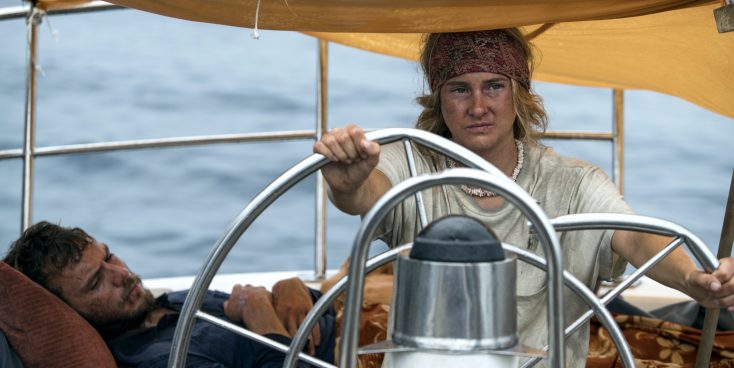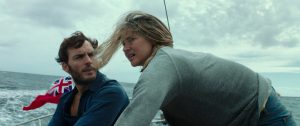By ANGELA DAWSON and MELODY WAINTAL
Front Row Features
HOLLYWOOD—Shailene Woodley, who stars with Sam Claflin in the seafaring adventure, “Adrift,” admits in an interview that she had almost no boating experience when she signed on for the project. Like her character in the action-packed film, though, she had to learn quickly. It was literally sink or swim. Known best for her breakout performance in 2011’s “The Descendants,” playing George Clooney’s rebellious daughter, Woodley has gone on to star in a number of mostly dramas. Now starring in the popular TV series “Big Little Lies,” the 26-year-old L.A. native spoke about her newest film role, in which she plays a budding sailing enthusiast who, with her fiance, set course for a fun, high seas adventure aboard a yacht they are supposed to deliver from Tahiti to San Diego, and wind up fighting for their survival when a hurricane strikes.
“Adrift” is based on the real-life experience of Tami Oldham Ashcraft, who wrote about her remarkable ordeal in the book “Red Sky in Mourning: A True Story of Love, Loss and Survival at Sea,” with writer Susea McGearhart. The film is directed by Baltasar Kormakur (“Everest,” “The Oath”), based on a screenplay written by Aaron Kandell, Jordan Kandell and David Branson Smith.
Q: What kind of research did you and Sam Claflin do to play your roles?
Woodley: We learned to sail. We kind of hope that when sailors see this movie they’ll be like “Oh, Sam and Shai know how to sail,” but I don’t know that they’ll do that. That was the great desire, to make this movie for sailors and for Tami (Oldham Ashcraft). There were a lot of hours at sea learning how to tie different ropes and learning a new language. So much of sailing is cerebral more than physical, so it’s like learning a completely new Rolodex of words.
Q: Have you ever had an experience like your character? You’ve done all you can and you can’t do anything more?
Woodley: We were all were teenagers once, right? Every day is an opportunity to grow from a challenge or be consumed by it. I can’t give you a specific moment because that would be very personal, but absolutely I can relate to the feeling of complete surrender and the ability to trust whatever it is that you choose to trust within or outside of yourself to allow you to keep going because you don’t physically have the energy to go on.
Q: You filmed a lot of this on an actual boat at sea. Was it fun or mostly challenging?
Woodley: Sailing is actually very hard even though it looks romantic.
Q: You’re wearing a tank top for a lot of this movie. Did you get cold?
Woodley: A couple of days were quite cold because we were filming in New Zealand in the middle of winter with ice cold water being dumped on us. Those days were cold but, for the most part, we were filming in Fiji under the hot sun day in and day out. Not a lot of chill.
Q: Do you consider yourself adventurous? Was making this movie an adventure?
Woodley: Filming this movie was up there in the list of the biggest adventures I’ve ever been on. A day felt like an adventure. But I can relate to (my character’s) vagabond nature and desire to see the world and immerse herself in different cultures and understand cultures from a local’s perspective.
Q: I know it was hard but was there something you really loved doing in making the film?
Woodley: Everything. A lot of it was challenging but when you get to see the sunrise and sunset from a boat on the ocean every single day, it’s hard to complain about anything and it’s hard not to find deep appreciation and gratitude for the once in a lifetime experience that you are witnessing alongside a group of really incredible individuals. So much of this movie was possible because of our crew. If we’d not had the crew that we had, this movie wouldn’t be what it is. We had people who disregarded sea sickness, who chose humor instead of complaints, who chose endurance instead of victimhood and that really made the experience fruitful for everyone. There was a time for all of us when one of us would get tired or sunburnt or there would be a moment of discomfort and someone would remind us that we were filming a movie based on a story that was real and, at the end of the day, we got to go back to our hotels and got food delivered to us…no matter what that food looked like, we still had food. We didn’t really eat very much.
Q: Some of the movie is different than the actual events. What was changed for the movie?
Woodley: Our movie is based on the book that Tami wrote and her format of it was past and present woven together, in and out. Also, the voice (she hears) was the overarching theme of the book, so there wasn’t much artistic license used to make the film. It was mostly honoring how Tami herself chose to share her story.
Q: How was your experience meeting Tami in person?
Woodley: She was in Fiji for about two weeks and I only saw her a couple of times. We all went to lunch but I had spoken and Skyped with her for many months prior to that so I was comfortable around her but meeting her in person everything hits you on a new level of “I’ve got to do everything I can to honor her story.” She’s given me her trust and now I have to treat that simple gesture with the utmost reverence and respect. After everything that happened, when she met Sam, she became speechless.
Q: When you were in the water, how did they protect you from the wildlife…sharks and the like?
Woodley: I had a spear. We had an amazing stunt team who took the utmost care and precaution when it came to protecting, not only us, but the whole crew. But, at the end of the day, you are filming on the ocean and no matter how professional you are, or good at your job you are, you are on the open sea and there are elements that can’t be guessed and weather patterns that shift quite drastically very quickly. So, everyone learned very quickly that we had to trust one another and take someone’s word for caution seriously. If there was a small chance at a threat, everyone really had to pay attention.
Q: What did you discover about working with Mother Nature on this film?
Woodley: The art of sailing taught me so much about how I don’t pay attention to the elements on the level that I wish I did. To be a sailor, it sounds simple to say, but you need to know which direction the wind is coming from and when it shifts. You are forced to constantly be in communication with nature, with the wind and the current. It’s just that language that I wish I had more of a connection to.
Q: How are your real survival skills? Would you survive if stranded somewhere alone?
Woodley: The biggest key to survival is your mental ability but when you are in that situation, who knows? I wouldn’t be able to survive at sea like Tami because I can’t use a sextant. So much of our lives now are dependent on technology that we’re not taking the time to utilize the tools that ancient navigators or mountaineers and sea men or people who live in the woods utilized and when accident happened and all the electronics went down, if she hadn’t known how to use the took that cross-references the sun with the horizon or the stars to the horizon then she wouldn’t have made it. So, as strong as she was mentally and as much endurance as she had she also had the skillset that wasn’t dependent on technology.






